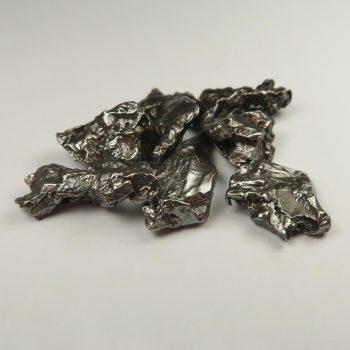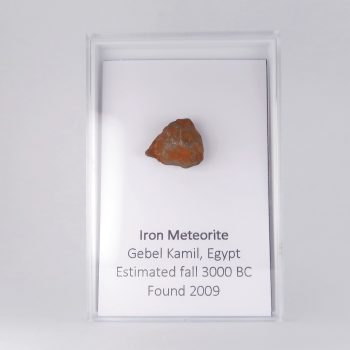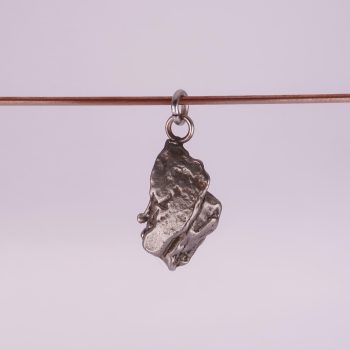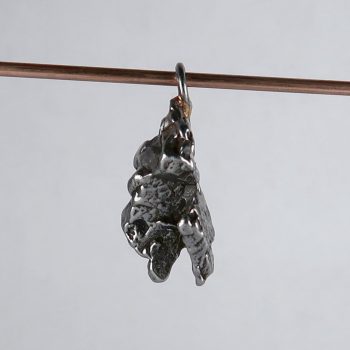Meteorites
We sell a wide range of meteorites, including natural pieces, shrapnel, whole meteorites, and slices.
Our stocks do vary quite wildly in this section – some products will have photos of the exact item you’d receive. The lower priced items will not!
Showing all 4 results
-
Updated

Campo Del Cielo Meteorite Specimens
Price range: £3.50 through £10.00 -

Gebel Kamil meteorite specimens
£20.00 -

Meteorite pendants (Aletai)
£20.00 -

Meteorite pendants (Campo del Cielo)
Price range: £12.50 through £25.00
Information about Meteorites
A meteroid is a small rocky or metallic body in outer space. As they enter the atmosphere and are heated, they are referred to as a meteor. When they strike a planets surface, they are referred to as a meteorite.
There are three main classifications of meteorite – iron, stone, and stony-iron.
Uses
Meteorites are used for a couple of things. Obviously, they make wonderful specimen objects for museums and collections, and smaller pieces at a lower price make amazing scientific gifts, especially for kids.
Jewellers sometimes use slices of Nickel Iron meteorites with a Widmanstätten pattern in jewellery. It contrasts quite nicely with Silver and Gold, and many people love the gorgeous striped patterns.
Some blacksmiths have made knives and other pieces from Meteoritic Iron. It was recently discovered that Ancient Egyptians used meteoritic Iron, including some items found in the tomb of Tutankhamen.
So… where do they come from?
I think an explanation of meteors and meteorites has to explain both their origin, and the ‘steps’ they take before they hit the Earth.
It isn’t easy to distil the information into a paragraph or two.
Essentially, in space, pieces fracture off comets, asteroids, pieces of debris from impacts into larger bodies, etc. As these head towards a planet, they are referred to as meteoroids.
When they enter the atmosphere, chemical reactions and friction cause it to heat up and form a ‘fireball’ or shooting star, which is correctly referred to as a meteor. When a meteor strikes the ground, it is referred to as a meteorite.
Some larger pieces are known as bolides, which are meteorites large enough to leave an impact crater.
Smaller pieces are referred to as micrometeorites or space dust.
Now, you may think meteorites are rare, valuable items, but they aren’t especially rare. There are around 40,000 well documented meteorite falls, and an estimated 15,000 tons of space dust, micrometeorites, etc fall every year. A lot burn up in the atmosphere, but many do land.
Okay! What are they made of?
While there are a lot of falls worldwide every year, this does not mean certain types of meteorite are not very valuable.
There are three broad classifications of meteorites, which are Stony Meteorites, Iron Meteorites, and Stony-Iron meteorites.
Stony Meteorites (Aerolites) are the most common type that falls to Earth; however, they tend to be similar in composition to Earth rocks, which makes them somewhat harder to identify.
There are two types of stony meteorites – chondrites, and achondrites. Chondrites have small spheres inside, which are typically Olivine or glassy, whereas achondrites do not.
Iron Meteorites (Siderites) are the most commonly found type, as they are relatively easy to distinguish from Earth rocks, and can be found with a metal detector. There have been some very large falls of this kind. The Campo del Cielo fall in Argentina and the Sikhote-Alin fall in Russia are both relatively common and we often have pieces in stock from those falls.
Stony-Iron meteorites (Siderolites) are somewhat rarer, and contain proportions of both minerals and metals. There are two kinds, mesosiderites and pallasites. Mesosiderites are a brecciated stone with Iron, whereas Pallasites are an Iron matrix with minerals embedded – typically Olivine. These pieces are quite sought after, and are sometimes sold polished into slabs or spheres.
Locales
These pieces can land anywhere on Earth! As they are extra-terrestrial, there are no ‘locales’ other than the areas where large meteorites have impacted.
Hazards and warnings
As meteorites are rocks or pieces of metal from space, you cannot guarantee their composition without expensive testing. Most of the pieces we sell are lower end, and do not contain any exotic minerals or inclusions.
However, one very common issue would be the Nickel content in Iron-Nickel pieces; an estimated 10-20% of the population has a Nickel allergy.
Obviously, there are dangers from Meteorite falls themselves! An American woman was injured by a fall in 1954.
A meteorite fall in Peru in 2007 actually led to illness through locals inhaling boiled vapours from groundwater.
Translations
| Arabic | نيزكنيزك | Hausa | Russian | метеорит | |
| Bengali | উল্কা | Hungarian | Meteorit | Spanish | Meteorito |
| Burmese | ဥက္ကာခဲ | Italian | Swahili | ||
| Chinese | 陨石 隕石 |
Japanese | 隕石 | Swedish | Meteorit |
| Czech | meteorit | Javanese | Meteorit | Tamil | விண்கல் |
| Dutch | meteoriet | Korean | 운석 | Telugu | ఉల్కలు |
| Esperanto | meteorito | Malay | Thai | อุกกาบาต | |
| Farsi | شهاب سنگ | Marathi | उल्का | Ukrainian | метеорит |
| French | météorite | Polish | Meteoryt | Urdu | |
| German | Meteorit | Portuguese | Meteorito | Vietnamese | mảnh thiên thạch |
| Greek | αερόλιθος | Punjabi | |||
| Gujurati | ઉલ્કાના | Romanian | Meteorit |
External links and further reading
Wikipedia page: https://en.wikipedia.org/wiki/Meteorite
Encyclopedia Britannica page: https://www.britannica.com/science/meteorite
University of Leicester page on meteorites: https://www2.le.ac.uk/departments/physics/research/xroa/astronomical-facilities-1/educational-guide/meteorites
